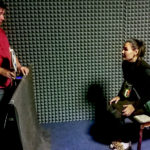Kazakh Startup Helps Blind Through Echolocation
Although bats can see, many species have evolved an unusual way to fly and hunt in the dark—echolocation. To do so, they emit ultrasonic sound waves that bounce off objects and navigate using the resulting echoes. Can this technique be used by people without sight? An innovative start-up in Kazakhstan, Sezual, has developed echolocation for human beings, with support from the World Bank. Sezual’s device, with special training, helps blind people “see” objects in three dimensions within a radius of 15 meters. Worn around the neck, it emits a high-pulse click that reflects off surrounding objects, providing information on their distance and shape that can be processed in 3D in the visual cortex of the user’s brain. It can even identify what material the object is made from. The device allows the visually impaired to navigate space freely, to work, travel, and live a full life.
Learn about our two Decals!
 Click here to find out more about our Fall Bioinspired Design Decal and our Spring Bioinspired Design in Action Decal – ALL MAJORS are welcome.
Click here to find out more about our Fall Bioinspired Design Decal and our Spring Bioinspired Design in Action Decal – ALL MAJORS are welcome.Berkeley BioDesign Community
 Click here to learn about the BioD: Bio-Inspired Design @ Berkeley student organization or here to signup for more info.
Click here to learn about the BioD: Bio-Inspired Design @ Berkeley student organization or here to signup for more info.Search
Student Login




I imagine that the neurological circuits underlying these processes are governed by both 2d spacing maps with their brains as…
to reduce the impact of car accidents, it may be possible to study the force diverting physics of cockroaches to…
you see this type of head-bobbing stability in many avian creatures related to pigeons like chickens. the head ability to…
not like they taught horses how to run! this is an example of convergent evolution where both sea creatures and…
The brain functions in a similar way with neuronal connections. our brains are able to utilize the multiplicity of connections…